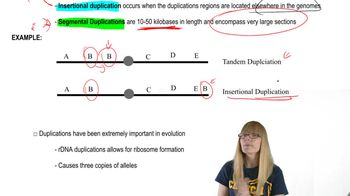Table of contents
- 1. Introduction to Genetics51m
- 2. Mendel's Laws of Inheritance3h 37m
- 3. Extensions to Mendelian Inheritance2h 41m
- 4. Genetic Mapping and Linkage2h 28m
- 5. Genetics of Bacteria and Viruses1h 21m
- 6. Chromosomal Variation1h 48m
- 7. DNA and Chromosome Structure56m
- 8. DNA Replication1h 10m
- 9. Mitosis and Meiosis1h 34m
- 10. Transcription1h 0m
- 11. Translation58m
- 12. Gene Regulation in Prokaryotes1h 19m
- 13. Gene Regulation in Eukaryotes44m
- 14. Genetic Control of Development44m
- 15. Genomes and Genomics1h 50m
- 16. Transposable Elements47m
- 17. Mutation, Repair, and Recombination1h 6m
- 18. Molecular Genetic Tools19m
- 19. Cancer Genetics29m
- 20. Quantitative Genetics1h 26m
- 21. Population Genetics50m
- 22. Evolutionary Genetics29m
6. Chromosomal Variation
Chromosomal Rearrangements: Duplications
Problem 29
Textbook Question
Describe at least two mechanisms by which duplicate genes arise. What are the possible fates of duplicate genes? Does the mode of duplication affect possible fates?
 Verified step by step guidance
Verified step by step guidance1
Step 1: Understand that gene duplication is a major source of genetic material for evolutionary innovation, providing raw material for the development of new functions.
Step 2: Identify two primary mechanisms by which duplicate genes can arise: (1) Unequal crossing over during meiosis, where homologous chromosomes misalign and exchange unequal segments, leading to duplication on one chromosome and deletion on the other. (2) Retroposition, where an mRNA transcript is reverse-transcribed and inserted back into the genome, often resulting in a duplicate gene without introns.
Step 3: Explore the possible fates of duplicate genes: (1) Nonfunctionalization, where one copy accumulates deleterious mutations and becomes a pseudogene. (2) Neofunctionalization, where one copy acquires beneficial mutations that confer a new function. (3) Subfunctionalization, where both copies partition the original function, each specializing in part of the original gene's role.
Step 4: Consider how the mode of duplication might affect the fate of duplicate genes. For example, duplicates arising from unequal crossing over might retain regulatory elements, making them more likely to undergo subfunctionalization, while retroposed duplicates might lack these elements, influencing their evolutionary trajectory.
Step 5: Reflect on the evolutionary implications of gene duplication, recognizing that it can lead to increased genetic diversity and complexity, providing opportunities for adaptation and innovation in organisms.
Recommended similar problem, with video answer:
 Verified Solution
Verified SolutionThis video solution was recommended by our tutors as helpful for the problem above
Video duration:
2mPlay a video:
Was this helpful?
Key Concepts
Here are the essential concepts you must grasp in order to answer the question correctly.
Gene Duplication
Gene duplication is a process where a segment of DNA is copied, resulting in two identical or similar genes. This can occur through various mechanisms, such as unequal crossing over during meiosis or retrotransposition. The presence of duplicate genes can provide raw material for evolution, allowing one copy to maintain its original function while the other may acquire new functions or mutations.
Recommended video:
Guided course

Duplications
Fates of Duplicate Genes
Duplicate genes can follow several potential fates after their formation. They may become nonfunctional due to mutations (pseudogenes), retain their original function, or diverge to take on new functions (neofunctionalization). Additionally, they can also undergo subfunctionalization, where each duplicate retains a subset of the original gene's functions, allowing for specialization.
Recommended video:
Guided course

Duplications
Mode of Duplication
The mode of gene duplication can influence the subsequent fates of the duplicate genes. For instance, whole-genome duplications often lead to more significant evolutionary changes compared to smaller-scale duplications. The context in which duplication occurs, such as the genomic environment and selective pressures, can determine whether duplicates are preserved, lost, or evolve new functions.
Recommended video:
Guided course

Duplications
Related Videos
Related Practice



